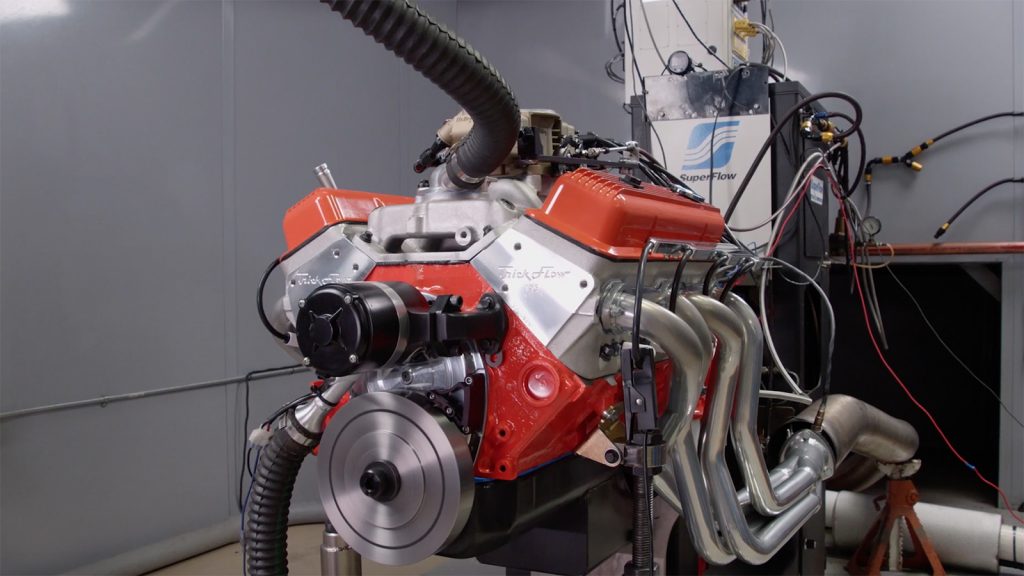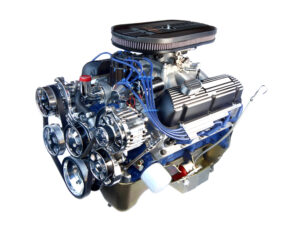The Small Block Transformed Chevrolet Into a Performance Brand

In 2011, General Motors announced they’d be commemorating a defining chapter in their 110-year history. The automotive manufacturer released news that their 100-millionth Small Block Engine would be rolling off the line, which is a feat unlike any other. How many automakers can boast this type of achievement? We’ll wait.
Chevrolet was founded in Detroit on November 3rd, 1911 by William Crapo “Billy” Durant, and Swiss race car driver and engineer by the name of Louis Chevrolet, and they produced six classic models in 1912, 1913, and 1914 – all of which were almost identical. In 1912, the price for their models was $2,150, equating to $62,442 today, adjusted for inflation. Not quite the affordable brand we’re all accustomed to today.
The Small Block Redefined the Chevrolet Brand
Between 1929 and 1955, Chevrolet only offered six-cylinder engines, which was a hard sell for some when you had the Ford Flathead V8 as an option. Then chief engineer, Ed Cole, wanted to address the performance market. He set out to design a Chevrolet V8 that was lightweight, powerful, and was affordable to the masses. It had been already done by Ford but was a tall task for the brand.
Cole came up with an exceptional, yet simple solution. He designed a compact, efficient 90-degree V8 engine that featured a pushrod valvetrain, overhead valves, and 4.4-inch on-center bore spacing.
The original Small Block could produce up to 195 horsepower with the four barrel option. Only a few engines could come close to this power output, and it exceeded almost anything else on the market. Chevrolet jumped into the V8 market and made a splash, but it was only the beginning. Their engineers created new technology at a frenetic pace, increasing horsepower at unprecedented rates in their newest engines.
Only two years after its introduction, their engineers added fuel injection to the engine, increasing horsepower from an already decent 195 horsepower to an excellent 283 horsepower – one horse power for every cubic inch of its 283. Chevrolet had developed a game changer, and the Small Block is what transformed them into the performance brand they’re known for today.
The Small Block had as great of an impact as the Ford Flathead V8, and it soon became the first choice for grassroots racers. Chevrolet racing programs were powered by this engine, leading to wins in stock car, endurance, and the Trans-Am series. The Small Block also spawned the production of legendary cars, including the Camaro, Impala, Corvette, and Chevelle.
The Small Block Spawned Iconic Production Cars
Along with production of more than 100-million Small Blocks, the automaker has fitted them into some pretty iconic models that are still produced today. The 1969 Camaro Z/28 with a 302 ci could be the most fun vehicle with a Small Block in existence. That’s a touchy and subjective topic we’ll save for another time. The car was built around Mark Donahue’s success in the 1968 SCCA Trans Am competition.
Other than the Camaro, what’s more legendary than a Corvette? The car is practically royalty in the United States and abroad. The 1955 Corvette with a 265 ci Small Block V8 that produced 195 horsepower was brought into existence to revive sagging interest in the car, which is hard to believe when you think about Corvette today and its popularity. The 195 horsepower output was created to “stir up” excitement for the classic and led to race-car development and Daytona Beach speed trials.
The 1957 Corvette was also no slouch, and it was fitted with Chevrolet’s most advanced Small Block at the time. The 283 ci engine produced 283 horsepower, one horsepower per cubic inch. How incredible is that? The Rochester fuel-injected small block delivered its power at 6200 RPM.
The fuel-injected Small Block was the new standard for performance, and the sound was a feature that could not be downplayed. This particular Small Block changed the industry and shifted their focus toward a combination of exhaust sounds, performance.
Chevy’s Small Block Changed the Culture of Performance
The Chevy Small Block boasted impressive power outputs, compact dimensions, and a vast array of aftermarket parts, making it the most popular crate engine in the industry. Even today, the LS Swap has become so widespread, you’ll hear complaints about it being overdone. It’s a testament to what Chevrolet and General Motors have been able to accomplish, and something that won’t change anytime soon.
Engine enthusiasts and hot rodders alike have the option of choosing from a broad range of Chevrolet V8 crate engines. For example, they can pick a classic 350 ci Small Block that produces 290 horsepower, which is easy to modify, and most importantly, affordable for someone looking to start a new project.
Jim Campbell, former vice president of GM Performance Vehicles and Motorsports goes as far as saying that “more people do more things with a Small Block than any other engine, and probably more than all other engine platforms combined. There’s a Small Block to fit almost any hot rodder’s needs, whether they are building a gold-plated hot rod, a 1,000-horsepower dragster, or an emissions-compliant project car.”
The Small Block Continues to Evolve
Despite the brand selling more four-cylinder engines than V8s today, the Small Block lives on. You can find Small Blocks getting swapped into Honda Civics, Toyota Tacomas, and even Ford and Dodge trucks. It’s proof of its following and admiration from enthusiasts willing to break traditions. Despite its evolution, it’s still based on the components in configuration of the first Small Block. However, the newest iterations are much more efficient at producing horsepower, and according to Green Car Reports, can get over 25 miles per gallon!
The current Small Blocks are descendants of the 1955 Small Block. According to General Motors, these engines retain the 90-degree V-configured eight-cylinder layout, overhead-valve placements, and pushrod valve train. The primary differences between the older and modern iterations are aluminum blocks, Active Fuel Management, titanium connecting rods, and variable valve timing.
The Small Block also has its place in NASCAR as the most winning name in their long history. It has also pushed the Corvette Racing team to eight class victories at the 24 Hours of Le Man since 2001, further proof of their success on both the road and track.
When the Small Block isn’t winning races, it’s powering Chevy’s line of full-size trucks, including their Silverado’s and Suburban’s. All these years later, they’re still powering Camaro’s and Corvette’s, delivering efficiency, durability, and horsepower figures that were inconceivable when it debuted.
Despite many country’s objectives to abandon the internal combustion engine, the Small Block Chevy will live on under the hoods of project and race cars for the foreseeable future. It’s given enthusiasts on all budgets the chance to follow their dreams and build a project because of its affordability. Its impact on the auto world should never be understated, and it will forever remain one of the greatest innovations in history.









